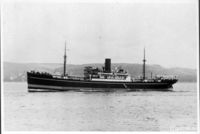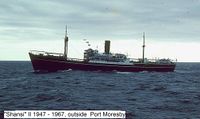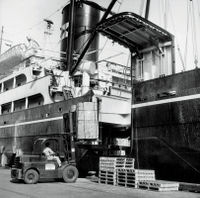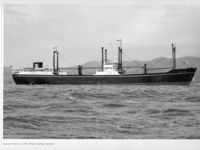New Guinea Australia Line
Contents
History
The China Navigation Company first became involved in
the Papua New Guinea trade in 1939, when Yunnan took
over the copra trade from the German company Nord
Deutscher Lloyd, (now Hapag Lloyd) which had been
banished from Allied territorial waters by the outbreak
of World War II in Europe. In those early days, special
boats were carried on board to lift copra directly from
the beaches.
Needless to say, this service ceased with the start of
the Pacific War, and CNCo did not re-enter the trade until
December 1952, when an Australia-Papua New Guinea
service was inaugurated as part of a long-term development
plan to give the company an Australian base. This trade,
together with that to the Solomons and New Hebrides, had
previously been monopolised by the Australian line Burns
Philp – then the largest operator in New Guinea – which
also generated much of the cargo. However, the rapid
post-war growth of trade between Australia and PNG made
room for an additional carrier.
The new service was given the ponderous title “New
Guinea Australia Line of The China Navigation Company”,
widely known as NGAL. The general agent in Sydney was
G.S. Yuill, (later Swire & Yuill), and the long-established
PNG trading group, Steamships Trading Company (today
a Swire subsidiary) became CNCo’s agent at ports in the
former Territory of Papua, with Colyer Watson acting
as agent in the northern ports of New Guinea. (The
two territories had been amalgamated under Australian
jurisdiction in 1949 – eventually gaining full independence
in 1975). Colyer’s was absorbed by Steamships Trading
in 1962.
Initially, the post-war “S” class ships Shansi and
Sinkiang – originally built as China coasters and still
sporting their anti-piracy grilles – were employed on
a Sydney-Brisbane-Port Moresby-Samarai-Sydney 28-
day turnaround service, later extended to Melbourne.
Their sister-ship Soochow was added in mid-1953, after
conversion by Taikoo Dockyard to update and extend
her saloon passenger accommodation and to fit radar
(which neither of her sisters yet had); the other two vessels
were similarly upgraded in rotation. This service pattern
continued essentially unchanged until 1962 – periodically
supplemented by Fukien, a freighter with no passenger
certificate and therefore able to make occasional side-trips
carrying explosives to the goldmines at Wau or to load
timber in New Britain. Another addition was the veteran
Pakhoi (launched by Taikoo just prior to the Japanese
invasion of Hong Kong in 1941 and known affectionately in
the trade as “the packhorse”). Madang, Lae, Kavieng (where
the ships tied up stern-first to a palm tree), Honiara and
Wewak were regular ports of call. The “S”s also augmented
the Hadj vessels on annual British Phosphates Commission
charter for the “Recruit” service.
Back-loadings remained disappointing – primarily
because Burns Philp’s rights to the southbound copra trade
were government-protected – and NGAL’s return cargoes
were confined to small amounts of plywood and rubber
lifted at PNG ports. By the early 1960s, it was clear the
service could not support three vessels and from 1963, the
Melbourne-Port Moresby route was covered on a through
basis by the “Intermediate Service” vessels, Changsha and
Taiyuan, whilst Madang, Rabaul and Lae were eventually
ports of call for the “Anticlockwise Round-Australia Service”
by CNCo’s “W” class vessels, en route for the Far East.
By this time, the shipping industry was going through
a period of immense change, with three new cargo-carrying
options – all of them potentially offering huge reductions in
port time – coming to the fore. These were containerisation,
pioneered by the American line, Matson; roll-on, roll-off,
and “unit loading” – a concept introduced into the short-sea
trades by the Norwegian ship owner, Fred Olsen.
Given the fairly basic cargo handling facilities that
existed at island ports, it was the third option, unitisation –
the carriage of palletised cargo, worked through cargo
doors in the ships’ sides using forklift trucks – which won
the day. This system was relatively cheap to implement,
since conventional tonnage could be converted, rather
than necessitating a whole new building programme, and
existing port infrastructure required minimal upgrading.
In 1966, CNCo purchased the 2,224grt Norwegian flag
Bahia, which was converted by Taikoo Dockyard in Hong
Kong – under extremely trying conditions, during a period of serious rioting. Drastic surgery on the vessel included
cutting two large hatches in her port side, fitted with
manually-operated cargo doors and adding strengthened
tween-decks in the ship’s holds to allow for one-high pallet
stowage – necessary to minimise cargo damage in transit
and allow deck-to-deck handling by forklifts; the ship
carried six of her own forklift trucks.
Though this was pioneering stuff in the Pacific, it is
worth noting that side-ports were scarcely a new departure
for CNCo and were in fact a feature of pre-war tonnage –
with cargo at China coast and Yangtze ports being “walked”
out of the holds by the coolie shore gangs. The key to the
Fred Olsen design, however, was that it entailed cutting
into the weather deck to install the side-port doors – a
revolutionary idea for which he obtained the sanction of
classification society DNV – and this made them much
more efficient than old fashioned side-ports in the hull.
The newly converted ship was named Papuan Chief
after an early vessel operated by CNCo’s agent, Steamships
Trading, during the 1920s. It was a name that still carried a
great deal of goodwill in PNG. Papuan Chief was introduced
into the trade in 1967, in her first year of operation lifting
an average 2,250 tons per northbound voyage – a slight
improvement on the combined performance of Shansi
and Soochow. Cargoes into PNG now included rice, sugar
and flour from Australia, consumer goods and small trucks,
whilst copra was still the main southbound cargo.
Encouraged by this success, China Navigation set
about converting a number of other ships to side-port
operation. The first of these, in 1968, was the 5,588-tonne
Tsingtao, previously employed in the Australia-Japan wool
trade. A larger, faster ship than Papuan Chief, Island
Chief, as this vessel was renamed, was less suited to pallet
work and did not achieve as good productivity rates. Coral Chief (ex-Chekiang), 5,790 tonnes, joined the service in 1969 to replace Papuan Chief, which had been chartered
to Burns Philp for their islands trades. There followed
Island Chief II (ex-Chefoo) in 1970, and New Guinea Chief
(ex-Kwangsi) in 1971 – the latter with deep tanks to carry
coconut oil and additional refrigerated space.
In January 1970, after some earlier experiments with PNG crews on Coral Chief, NGAL opened its own training school at Port Moresby to teach basic seamanship skills. Selecting its trainees mainly from the Samarai region in southern Papua, where there was a strong seagoing tradition, the school was an outstanding success and Papuans gradually replaced Chinese crews on NGAL ships. This initiative was part of a general move towards localisation and in September of the same year, the New Guinea Australia Line Pty Limited was registered in Port Moresby – the shares being held equally by Swire and long-time associate, Ocean group; the ships continued to be owned by CNCo, but were chartered and operated by the local company.
For further reading see the book In Coral Seas - The History of the New guinea Australia Line which is based on the manuscript by Martin Speyer, published in 2004, by The Nautical Association of Australia Inc. in association with John Swire & Sons




